SintraCascaisSesimbra.com
The best independent guide to Sesimbra
SintraCascaisSesimbra.com
The best independent guide to Sesimbra
Cabo Espichel - A tourism and day trip guide for 2026
Cabo Espichel is a place of raw, elemental beauty, a windswept headland where towering limestone cliffs plunge into the ferocious waves of the Atlantic. This dramatic cape marks the southwestern tip of the Setúbal Peninsula, a landscape so formidable that the Romans knew it as Promontorium Barbaricum - the Barbarian Cape, on the edge of the known world.
Yet this seemingly desolate landscape is rich with secrets, revealing layers of history that span millions of years. At its heart lies the Santuário de Nossa Senhora, a magnificent 18th-century sanctuary built to honour centuries of divine apparitions and pilgrimages. This human devotion shares the cliffs with a much deeper past: the fossilised footprints of dinosaurs, once famously misinterpreted as the tracks of a holy mule climbing from the sea.
This unique blend of geology, legend, and faith makes Cabo Espichel unlike any other destination on the Portuguese coast, and an unforgettable excursion from Sesimbra or Lisbon for those who appreciate nature's untamed power.
What is there to see at the Cabo Espichel?
Along with the coastal walks and views across the ocean, the four main sights of the Cabo Espichel are:
The Santuario de Nossa Senhora – An 18th-century church complex with two distinctive rows of accommodation buildings, constructed for pilgrims to the Cabo Espichel
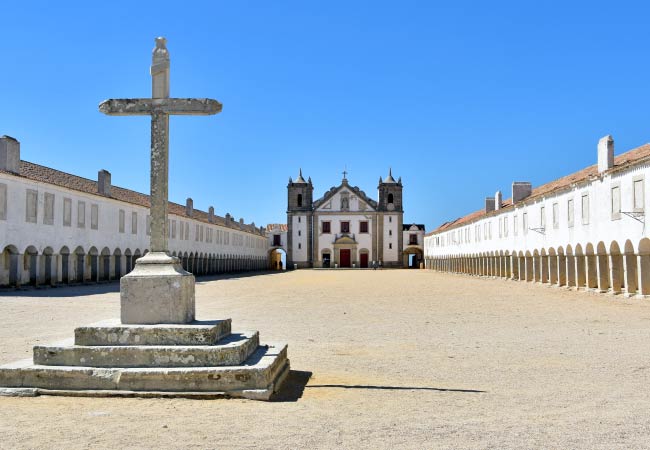
The Farol do Cabo Espichel – The powerful lighthouse which illuminates this treacherous headland
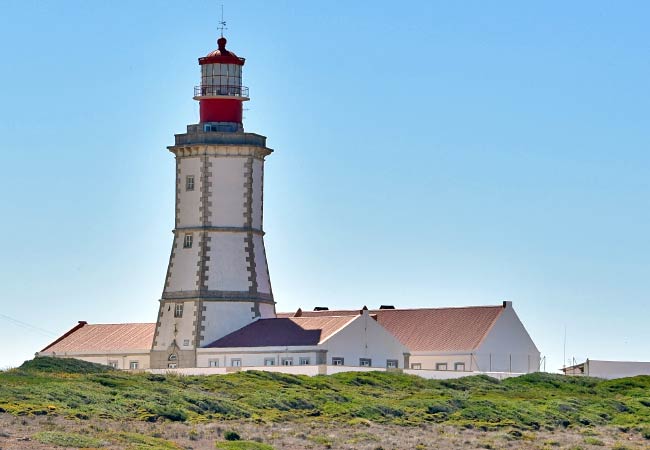
The Ermida da Memória – A tiny chapel constructed on the site of an apparition of the Virgin Mary (the Nossa Senhora), and once an important pilgrimage destination.
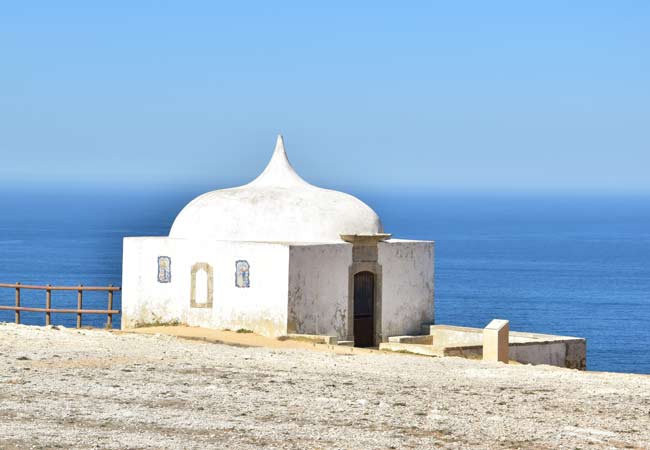
The Pedra da Mua and Lagosteiros – Two sets of dinosaur footprints that have been exposed within the cliffs.
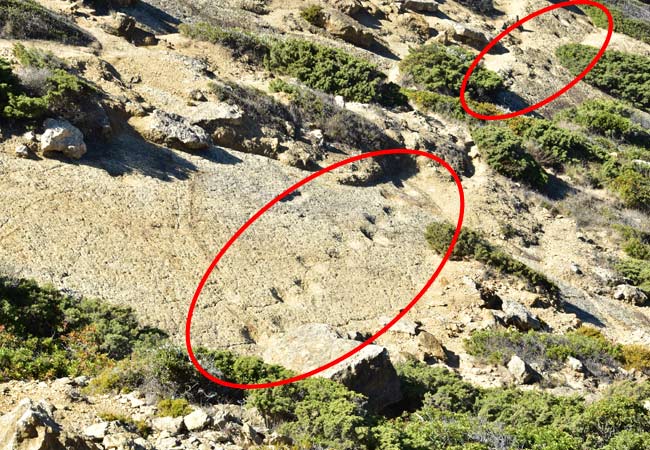
The Lagosteiros dinosaur footprints – without knowing what to look for they are very easy to miss!
How long to spend at Cabo Espichel?
A visit to the Cabo Espichel is not going to be that long.
Within 1 hour, you could easily see the Santuario de Nossa Senhora church, the Ermida da Memória chapel and the lighthouse, which is a 10-minute walk from the chapel.
From the church, it is a 20 minute round trip to see the Lagosteiros dinosaur footprints. This route passes the only safe place to view the Pedra da Mua tracks, which are on the side of a cliff below the Ermida da Memória chapel. A two-hour visit to the Cabo Espichel is sufficient time to have seen everything.
A brief stop (less than 20 minutes) is enough to see the Santuario de Nossa Senhora and the cliffs, and is ideal if you are visiting as part of a tour or by the very limited bus service.
If the heat, cold or wind gets too much, there is a decent café (I Love Espichel) for refreshments and traditional Portuguese home cooking, and is located close to the Nossa Senhora church.
To greatly extend a visit, consider the hike along the Maravilhas do Cabo (PR2-SSB route) or along the cliffs to the deserted Praia das Bicas beach (details later in this article).
Below is an interactive map of the sights of the Cabo Espichel. Note: zoom out to see all of the markers
Sights: 1) Santuario de Nossa Senhora 2) Ermida da Memória 3) Casa dos Círios 4) Casa da Água 5) Cabo Espichel lighthouse 6) Pedra da Mua (dinosaur footprints) 7) Lagosteiros (dinosaur footprints) 8) Maravilhas do Cabo (hiking route) 9) Praia das Bicas 10) Praia do Meco 11) Lagoa de Albufeira
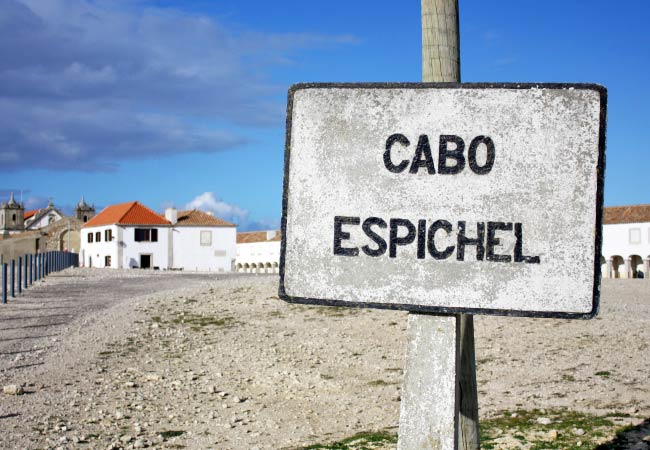
Where to visit next after the Cabo Espichel?
The southwestern tip of the Setúbal Peninsula is one of the least visited areas of the Lisbon region, and has lots of other interesting sights to continue a day trip here.
To the north of the Cabo Espichel is the beautiful Praia do Meco, a wonderful beach so long as it’s not windy. Further along the coast is the Lagoa de Albufeira, a tranquil lagoon that opens out onto the ocean and provides a unique dual-facing beach. The Lagoa de Albufeira is one of the hidden gems of the Lisbon region.
To the east of the Cabo Espichel is the delightful beach resort of Sesimbra and the port city of Setubal. Between these two towns are the Serra da Arrábida hills and the scenic N379 road.
Related articles: Lagoa de Albufeira - The Serra da Arrábida - Praia do Meco
The Legends of the Cape: Miracles, Mule Tracks, and Dinosaurs
The remote and dramatic cliffs of Cabo Espichel have long inspired a sense of awe and reverence. For centuries, this was a place of powerful superstitions and spiritual encounters, which eventually gave rise to one of Portugal's most important religious cults: Our Lady of Cabo Espichel.
Much of this mystique stems from its geology. The entire headland is a karst landscape, a plateau of limestone slowly dissolved by rainwater over millions of years. This process has created a network of sinkholes and sea caves, lending the area an air of mystery that made it fertile ground for legends.
The cape's transformation into a major pilgrimage destination stems from a series of miraculous legends. The most famous, concerning a giant mule, is actually the second chapter of the story.
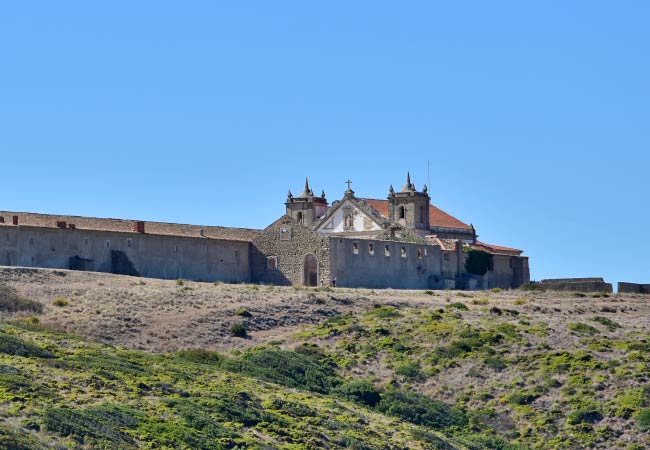
The founding miracle dates to the 12th century and involves two separate divine messages. An elderly man from Caparica was drawn to the coast by a mysterious light glowing from the base of the cliffs. There, he discovered a sacred icon of the Virgin Mary tucked inside a sea cave, impossible for him to reach alone. At the same time, an elderly woman from Alcabideche, across the Tagus estuary, had a vivid dream instructing her to travel to the very same spot.
The two strangers met on the clifftop, sharing their remarkable stories. With the help of local fishermen, they were finally able to retrieve the precious icon from the cave below. To honour this miracle and house the sacred image, the tiny Ermida da Memória (Chapel of Memory) was built right where they had met.
Centuries later, as the site's fame grew, a second and more spectacular vision occurred in 1410. An apparition of the Virgin Mary was seen rising from the ocean, riding a giant mule that climbed the impossibly steep cliffs before vanishing at the Ermida da Memória.
Amazingly, the tracks left by this giant mule actually exist and can still be seen today. They are, in fact, the fossilised footprints of a massive Sauropod dinosaur, now known as the Pedra da Mua dinosaur trackway. This misinterpretation of geology as a divine event fused the cape's spiritual and prehistoric history, turning it into a site of immense wonder and devotion for centuries to come.
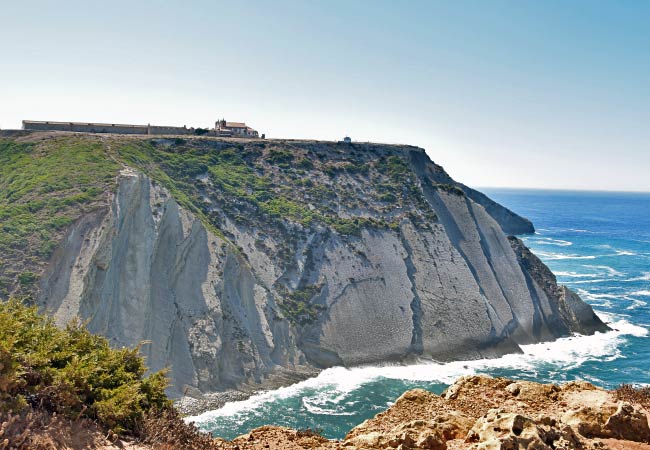
The mule was said to have climbed these cliffs to the small chapel at the summit
The Sanctuary: A Pilgrim Town on the Edge of the World
Fuelled by the legends of miracles, the fame of Cabo Espichel grew exponentially. The original, tiny chapel soon became overwhelmed. In response, King Dom Pedro II ordered the construction of a magnificent new complex in 1701 to serve the thousands of devoted travellers. This became the Santuário de Nossa Senhora do Cabo Espichel.
The spiritual heart of the sanctuary is the Baroque-style church, whose plain exterior hides a stunningly ornate interior, famous for its beautiful painted ceiling depicting the Assumption of the Virgin Mary.
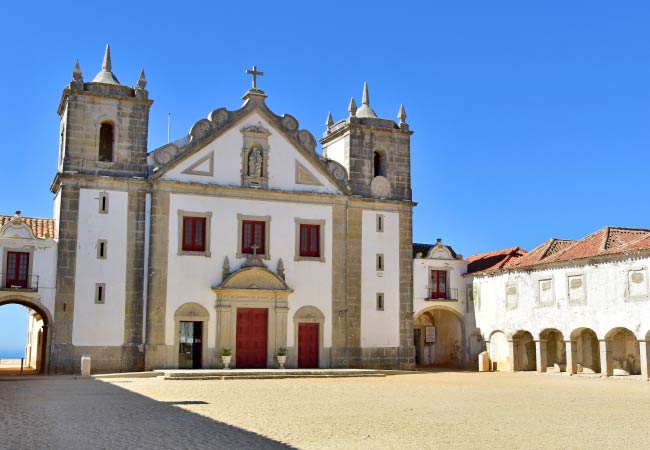
However, the most remarkable feature of the sanctuary is the two enormous symmetrical wings that flank the church. These were not mere hostels; they were the Casa dos Círios (the Pilgrims' Houses). At its zenith, the pilgrimage to Cabo Espichel was a major social and economic event, organised around brotherhoods from across Portugal known as Círios. Each group would travel for days, bringing their own banners and traditions, and stay at the cape for weeks at a time.
The Casa dos Círios functioned as a self-sufficient town. Each brotherhood was allocated its own section of lodgings, complete with kitchens, wood-fired ovens, and stables. For centuries, this isolated clifftop buzzed with life, transforming from a place of bleak wilderness into a vibrant festival site.
Sadly, with the suppression of religious orders in 1834, the pilgrimages ceased and the buildings fell into disrepair. Today, as you stand in the silent, windswept square, you can still sense the echoes of the bustling community that once thrived here. Thankfully, significant restoration efforts are now underway to preserve these unique historic buildings for the future.
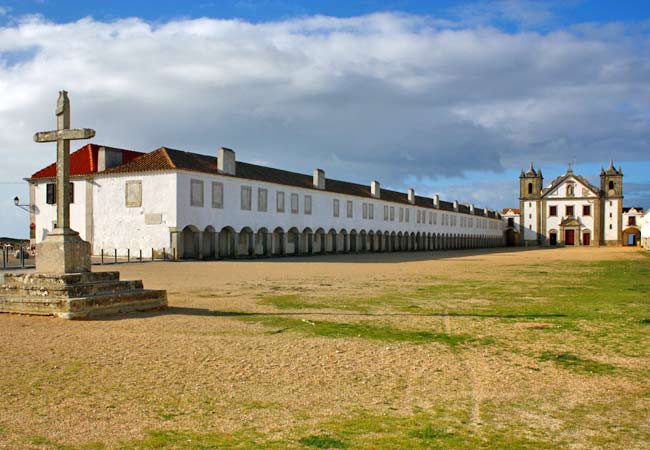
The Santuario de Nossa Senhora
The Casa da Água and the Royal Aqueduct
One of the greatest challenges for the bustling pilgrim town was its most basic need: fresh water. The windswept, limestone plateau of Cabo Espichel had no reliable source. To solve this, King José I commissioned a monumental engineering project in 1770.
A royal aqueduct was constructed, stretching for several kilometres across the countryside to carry fresh water from a spring near the village of Azóia all the way to the sanctuary. The ornate building at the far end of the courtyard, the Casa da Água (Water House), was the terminus of this waterway.
More than just a fountain, it was a celebration in stone, decorated with the royal coat of arms to signify the importance of the royal patronage.
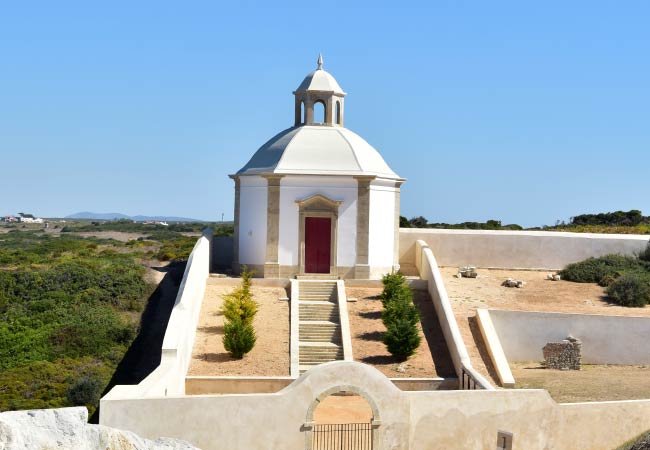
The Cabo Espichel Lighthouse
The Cabo Espichel Lighthouse was one of the most important lighthouses of the Lisbon coastline. The southwestern tip of the Setúbal Peninsula was notorious for shipping, as there are few major towns to illuminate the coast, and the region experiences ferocious Atlantic storms.
The original lighthouse was constructed in 1430, but the current 32m tower dates from 1790. On a clear night, the light from the Cabo Espichel Lighthouse can be seen up to 35km (22 miles) out to sea. The lighthouse is still in operation, and is closed to the public.

Dinosaur Footprints at the Cabo Espichel
Within the exposed and weathered cliffs of Cabo Espichel are two sets of dinosaur footprints; the Pedra da Mua and the Lagosteiros.
The Pedra da Mua tracks are embedded within the grey cliffs, directly below the Ermida da Memória chapel. These tracks were created by a herd of Sauropods (colossal four-legged dinosaurs) and include juvenile footprints and the irregular step of an injured animal.
As the prints are on the side of a near-vertical cliff, the only place to view them (from a distance) is from the opposite side of the bay.

The footpath to the Lagosteiros track and Pedra da Mua viewpoint
The Lagosteiros tracks are much easier to view but are less impressive. The Lagosteiros footprints were formed during the Cretaceous period, by a herd of Theropod and Ornithopod dinosaurs. The most interesting footprints are from a dinosaur that is running.
Insight: The two sets of dinosaur footprints are only 400m apart but are separated by almost 50 million years.

Without clear signage it’s very easy to miss the Lagosteiros footprints
The Ermida da Memória Chapel
The small Chapel of Ermida da Memória was an important early pilgrimage destination in Portugal. This was the chapel into which the apparition of the Virgin Mary on the mule vanished.
Inside the chapel, traditional blue and white azulejo tiles depict the mule and its footprints. The chapel is closed off to visitors, but the tiles can be seen through the glass door.
Insight: The tile painting in the Ermida da Memória is technically the world’s first-ever recorded existence of dinosaurs, even though it was believed to be a giant mule…
Hiking at the Cabo Espichel
The Cabo Espichel coastline provides a series of hiking trails. The two most popular are the Maravilhas do Cabo and the trail along the coast to the Praia das Bicas.
The Maravilhas do Cabo is a 5km circular route that takes in the two sets of dinosaur footprints and the deserted coastline to the north of the Cabo Espichel. A link to a leaflet can be found here (this is an external website, and the PDF may download on phones)
An alternative hiking route is to follow the coastal paths to the Praia das Bicas 6km to the north. This path ends at one of the most pristine and remote beaches of the Lisbon region.
Travel to the Cabo Espichel
There is very poor public transport to the Cabo Espichel, and it is always advisable to drive.
There is a large free car park near the church and a second car park at the start of the Maravilhas do Cabo footpath, which leads down to the dinosaur footprints.
Public transport to the Cabo Espichel is very limited. There is just a single bus route to the Cabo Espichel, which departs from Sesimbra bus station. This service is the 3205 route and is operated by Carris Metropolitana, and a single fare costs 2.60€. The latest timetable can be seen on the Carris Metropolitana website:
www.carris
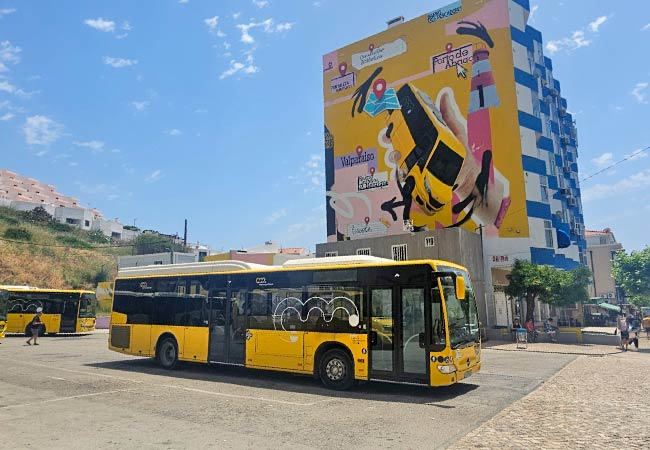
The Cabo Espichel bus waiting at Sesimbra bus station
Our most popular guides to the Sesimbra region




















